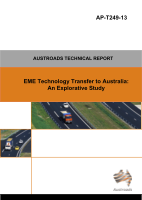Pavement

- Publication no: AP-T249-13
- ISBN: 978-1-925037-23-4
- Published: 11 October 2013
- PDF (free) Download
This study investigated the potential introduction of the French high modulus hot mix asphalt technology, called enrobés à module élevé (EME) to Australia. The EME mix technology provides a high performing asphalt material for use in heavy duty pavements, where the pavement carries large volumes of heavy vehicles, there are potential height constraints, or the traffic loading is considered extreme, such as slow lanes, climbing lanes, bus lanes and airport pavements.
Based on an international literature review, the historical development and performance of EME was investigated. In co-operation with the asphalt industry, the availability of the required materials such as suitable aggregates and hard penetration grade bitumen was also investigated. By using locally available constituent materials, a laboratory-based demonstration project was undertaken to provide insight and guidance for EME mix design. The mix design of EME differs from mix design approaches typically used in Australia in that it is strictly based on performance-related testing. The trial and error approach of the laboratory testing reported in the study also provides a good understanding for practitioners about the complex nature and requirements of an EME mix design.
- 1. Introduction
- 1.1. Objectives
- 1.2. Structure of the Report
- 2. Heavy Duty Asphalt in Australia
- 3. Development of High Modulus Asphalt Concrete in France
- 3.1. Development of Testing Methodology in France
- 3.2. Pavement Design Considerations
- 3.3. Manufacturing of EME and Practical Considerations for Construction in France
- 3.4. A Case Study from France
- 3.5. Design Properties of EME in France
- 3.5.1. Binder Content and Richness Modulus
- 3.6. Performance-based Mix Design of EME
- 3.6.1. Level 1 Testing
- 3.6.2. Level 2 Testing
- 3.6.3. Level 3 and Level 4 Testing
- 3.7. Requirements for Constituent Materials
- 3.7.1. Binder Types used in EME
- 3.7.2. Aggregate Grading of the EME
- 3.7.3. Aggregate Requirements
- 3.7.4. Richness Modulus
- 4. Other International Application of EME Mixes
- 4.1. Experience in the United Kingdom
- 4.2. South Africa
- 5. Experimental Program – EME Mix Design
- 5.1. Binder Test Results
- 5.1.1. Brookfield Test
- 5.1.2. Determination of Binder Viscosity Ranges for Mixing and Compaction
- 5.1.3. Preliminary DSR Test – Strain Sweep Test
- 5.1.4. DSR Test – Temperature-Frequency Sweep Test
- 5.2. Aggregate Test Results
- 5.2.1. Test Methods
- 5.2.2. Test Results
- 5.3. Mix Design Procedure – Trial Mixes
- 5.4. Mix Design Procedure – Performance of the Trial Mixes
- 5.4.1. Rut Resistance
- 5.4.2. Flexural Modulus
- 5.4.3. Fatigue Resistance
- 5.4.4. Moisture Sensitivity
- 5.4.5. Test Results Summary
- 6. Summary and Conclusions
- 6.1. Summary
- 6.2. Conclusions
- Workability with hard grade binders
- Moisture sensitivity (durability)
- Rutting resistance
- Stiffness properties
- Fatigue resistance
- References
- Appendix A Appearance of the Surfaces – Moisture Sensitivity Test Samples
- A.1 Tested According to AGPT/T232
- A.2 Tested According to EN 12697-12 (EN 12697-23)
